Zadar Digital Nomad Week Diary: Opening and Second Day
June 12, 2022 - After the success of the Zagreb Digital Nomad Week in 2021 and the Work.Place.Culture Conference in Dubrovnik this year, now it's turn of one of the most important cities in the Adriatic and one that continues to attract a large community of digital nomads. A review of the first day of Zadar Digital Nomad Week.
In one of the most ambitious projects of Saltwater Nomads to date, and in collaboration with the Zadar Tourist Board and the Digital Nomad Association Croatia, Zadar Digital Nomad Week presents a week-long program full of cultural and outdoor activities that will allow you to discover in-depth the advantages of being a digital nomad in Zadar. The event kicked off on Friday the 10th with an opening dinner at the Groppo restaurant, where participants and organizers were able to get to know each other better and share more about their stories, experiences, and backgrounds.

Photo: Jose Alfonso Cussianovich/Total Croatia News
The day started in front of the Foša Gate, in the old town of Zadar, where Rudi Witkowsky offered an active masterclass. Rudi, a fitness coach and consultant from Cape Town, South Africa, was Zagreb's digital nomad ambassador last year in August. Rudi has already been able to get to know numerous coastal destinations in Croatia since it is definitely the climate that he pursues as a digital nomad, but he highlighted Zadar as a fitness-friendly city, with enough provision and infrastructure for athletes and physical activity enthusiasts. In his active masterclass, Rudi guided those present to reconnect with their bodies through demanding exercise routines in tune with relaxation exercises, all this under the shade of the trees, taking into account the high temperatures that herald the arrival of summer.
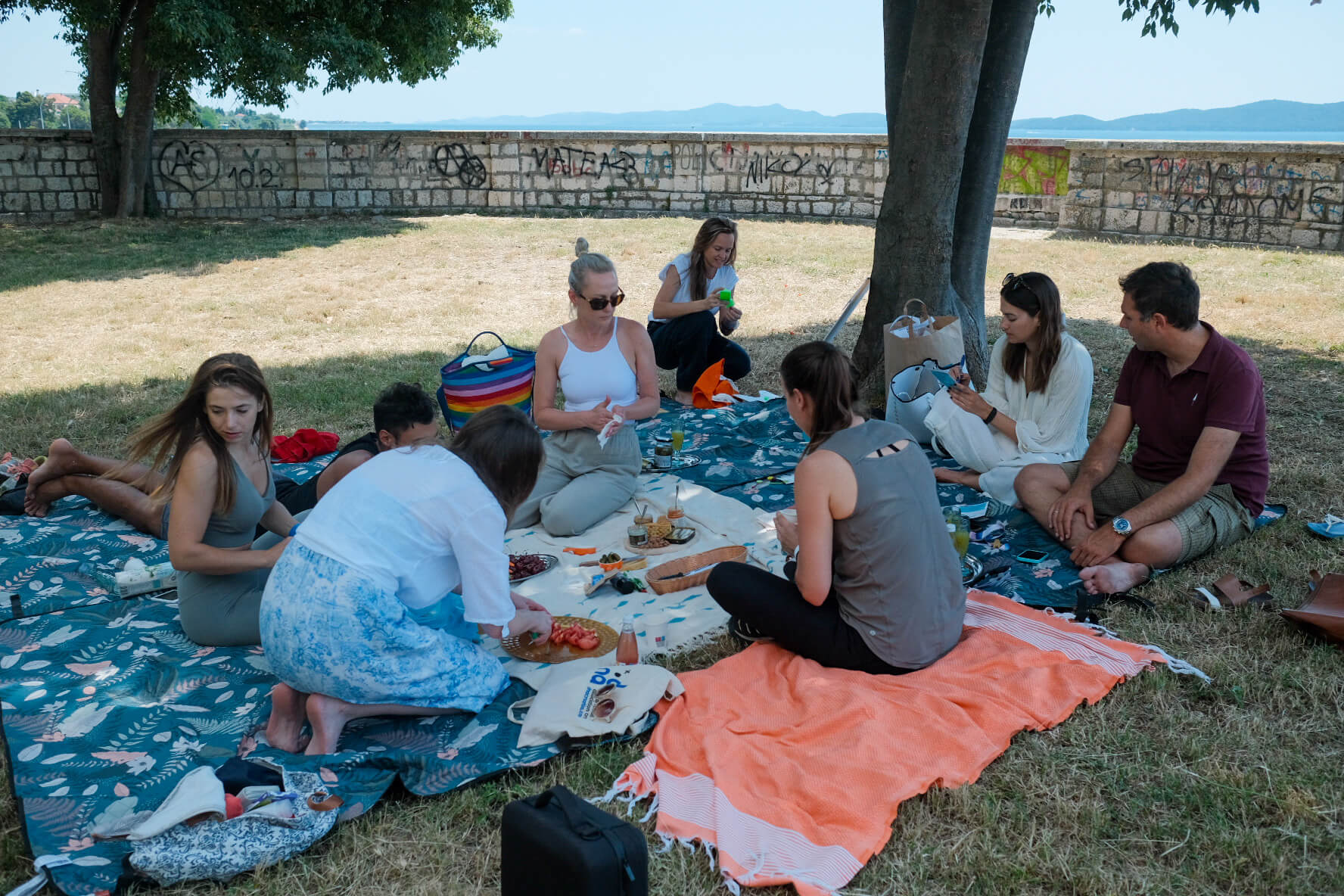
Photo: Jose Alfonso Cussianovich/Total Croatia News
Around noon, we got together for a very interesting activity that tested our knowledge about Zadar: the puzzle picnic. Through very creative clues, the participants were able to walk the ancient streets of the old town of Zadar while we deciphered the way to finally arrive at a location with surely one of the best panoramic views of the city. Under the shade of the trees, a well-deserved tasting session of Croatian prosecco, cheeses, fruits, and sponsored kombuchas appeased everyone's appetite and thirst after a long day of walking under the merciless sun — a proper reward.
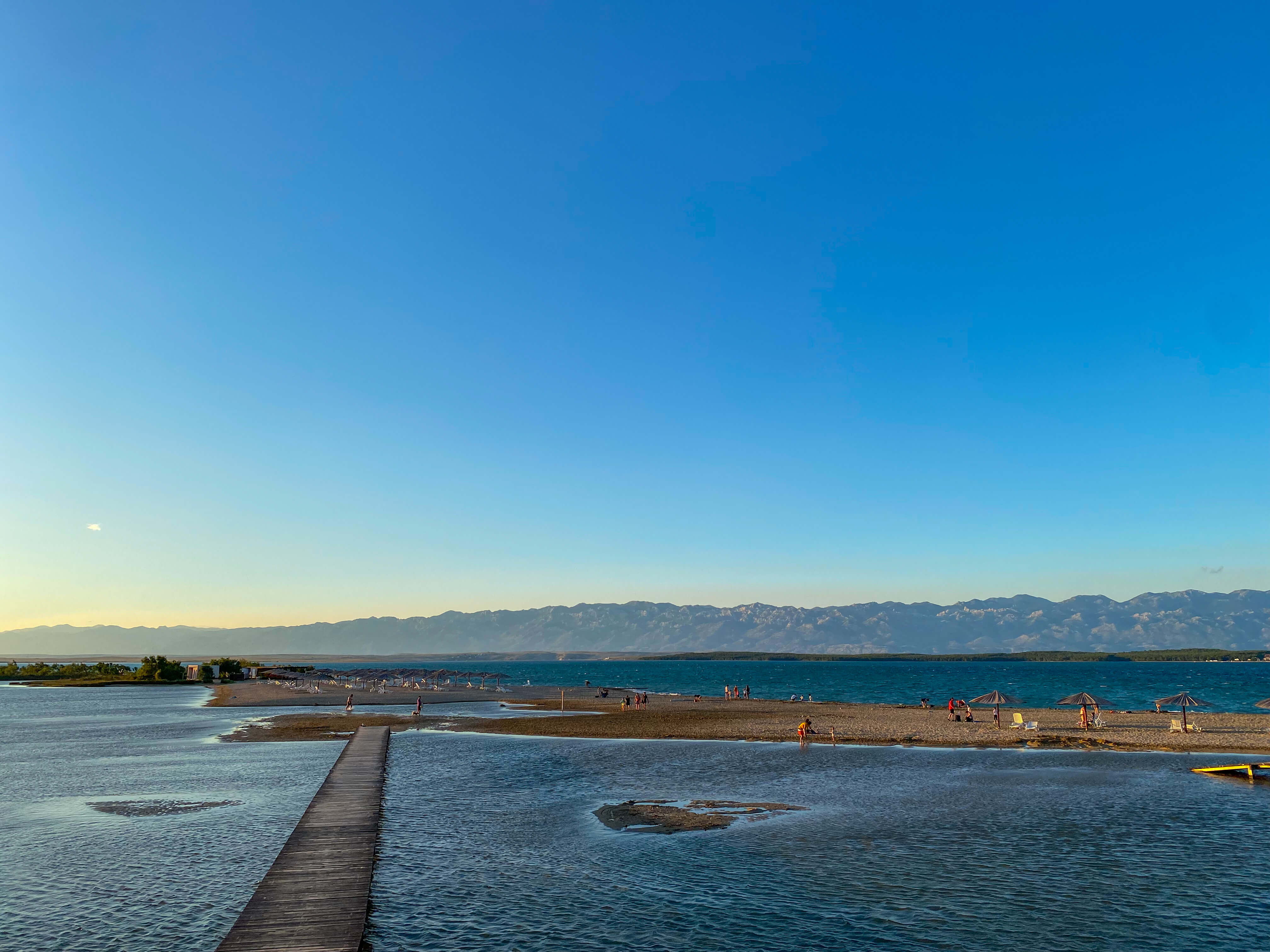
Photo: Jose Alfonso Cussianovich/Total Croatia News
There was no better way to end the first day than visiting the surroundings of the historic town of Nin, just 30 minutes from Zadar by car. It's almost seven in the evening, and it's the best time of day to take a bath, but one very different from what we're used to. At Queens Beach, visitors come to cover their bodies with mud well known for its therapeutic and healing functions. Mud baths are very popular in Croatia, especially in this part of the country. It is even known that this activity dates back to Roman times.
On the way back to Zadar, and without planning it, we stopped to take a look at the church of Saint Nicholas, a small church built on a small hill, and that keeps a short but very interesting history. According to tradition, seven Kings were crowned in Nin, and every crowned ruler rode on horseback to the Church of Saint Nicholas, and it was in fact here that he would be presented to the people through a symbolic ritual, where he would point with a sword the four corners of the world.
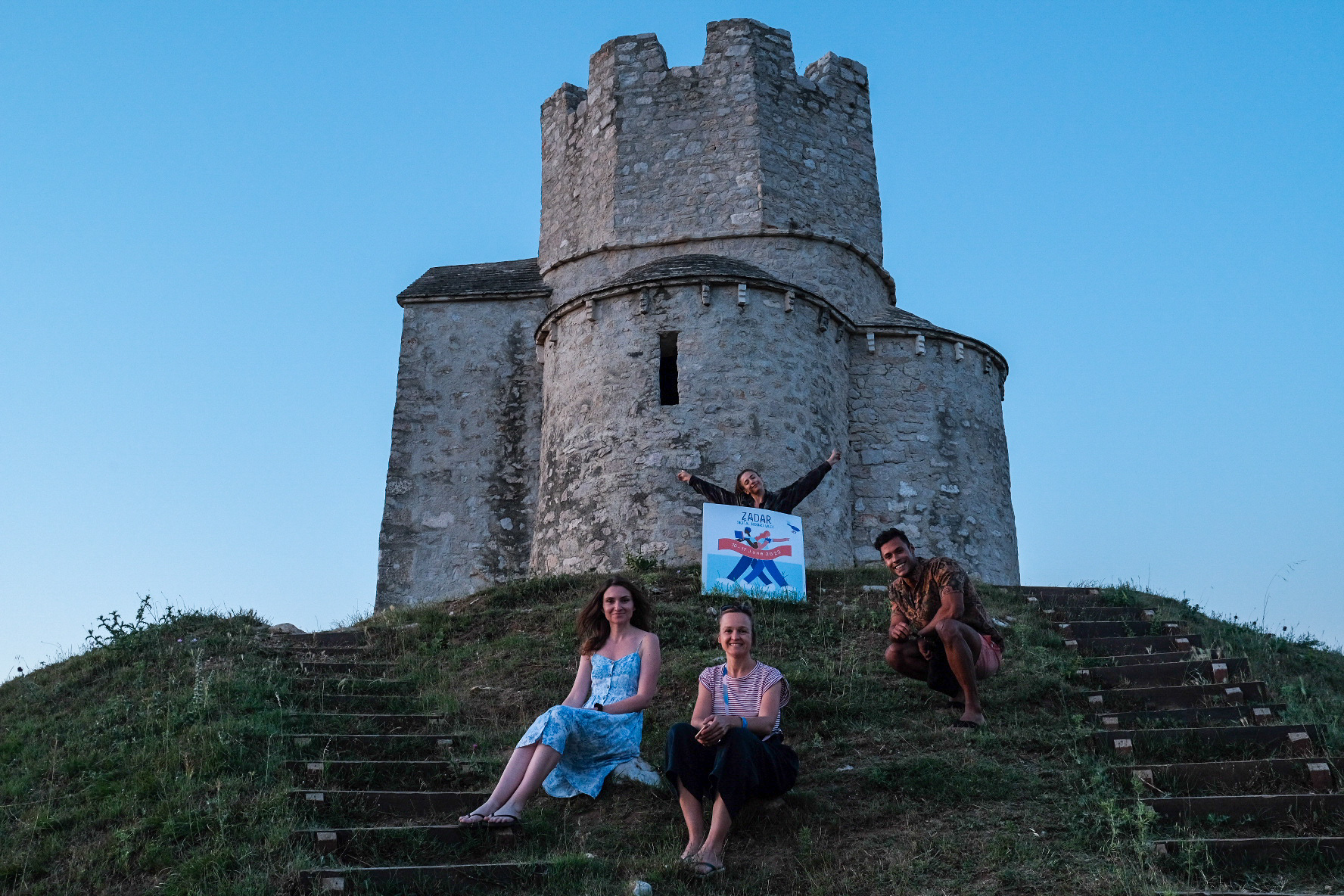
Photo: Jose Alfonso Cussianovich/Total Croatia News
It was an excellent opening of the Zadar Digital Nomad Week, which presented the city in a great way, and it is best to know that there is still much to enjoy from its rich program. The second day awaits Turkish coffee and baklava, keynote in a kayak, and much more.
Visit the official Zadar Digital Nomad Week website.
For the latest news and features about digital nomads in Croatia, check out the dedicated TCN section.
Nin Šokolijada Kicks Off for Its 20th Anniversary Edition
January 11, 2022 - The Tourist Board of the City of Nin invites all interested participants to apply by 31 January 2022 for the 20th Nin Šokolijada Festival. It is a unique international gastronomic event that celebrates an important brand in the city of Nin.
The Nin šokolijada is a unique dried meat product made from pork neck. It is scarce and difficult to find because it is done only in Nin and the Nin coast.
The art of making the šokolijada is, by its very nature, an intangible cultural heritage. Since 2003, the Tourist Board of the town of Nin and its diligent families have been keeping alive the art of making a unique delicacy according to preserved family recipes.

Photo: Ana Glavan
According to Marija Dejanović, project manager of the Nin Šokolijada Festival and director of the Tourist Board of the city of Nin, there are very few self-effacing, unique, extremely high-quality, and rare delicacies. Therefore, a lot of effort is needed to preserve and continue this tradition.
The Nin Šokolijada, with the announcement of the winner or the best šokolijada, is planned for July 17 this year. Of course, the manifestation will be adjusted to epidemiological measures. The invitation is accompanied by a public thank you to all previous competitors who have preserved the skill of making schools with their families, an important intangible cultural asset of the Nin region.
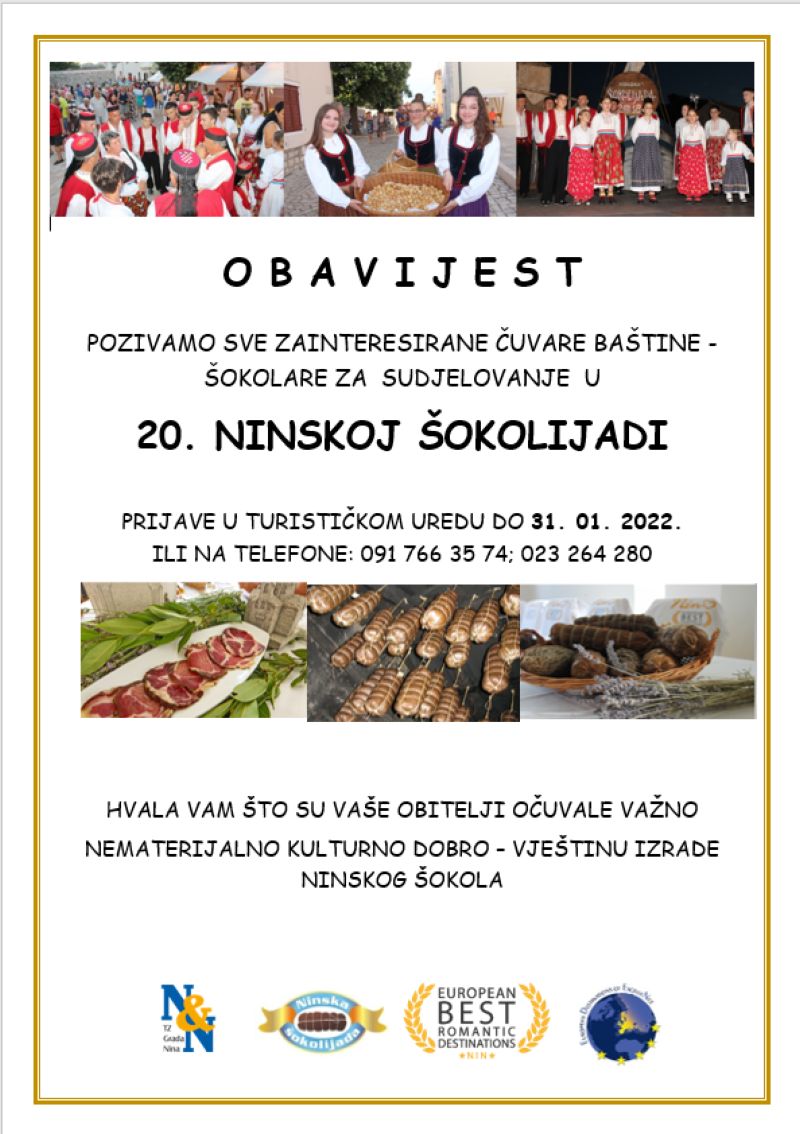
Last year's third part of the Nin Šokolijada event was not organized due to COVID measures. That part of the event is always the most interesting to the public, so many visitors came to Nin and had the opportunity during the exhibition weekend program to taste the Nin šokolijada, an indigenous delicacy that is well known as a tradition of the region and its recipe has remained a secret from local families.
Source: Turističke Priče
Find more information about everything the City of Nin has to offer you through its Tourist Board website.
To read more about lifestyle in Croatia, follow TCN's dedicated page.
Living History, a New Way to Learn the Rich History of Nin
September 30, 2021- This year, World Tourism Day was held under the theme Tourism for Inclusive Growth. As part of the celebration, the Living History program was organized in Nin, which is used as a method of interpreting historical heritage.
According to Turističke Priče, the Living History program was organized by the City of Nin Tourist Board, and using the motto ''Get to know the history of the royal city of Nin'', two days were dedicated to this topic. The groups were led by a tourist guide dressed in the clothes worn by the author of the Mountain Petar Zoranić Ninjanin at the time when, according to known data, he worked as a court notary in Nin. He was accompanied by a tourist guide who wore the uniform of a Croatian villa, which appears in the first Croatian novel.
Costumed guides guided tourists during the season, but this time they had a very demanding task. In front of them in the group were tourist workers and students from the area of the town of Nin and beyond, who already had some prior knowledge about the first capital of the Croats. The challenge was to interpret history in a new way and supplement it with those important and little-known data.
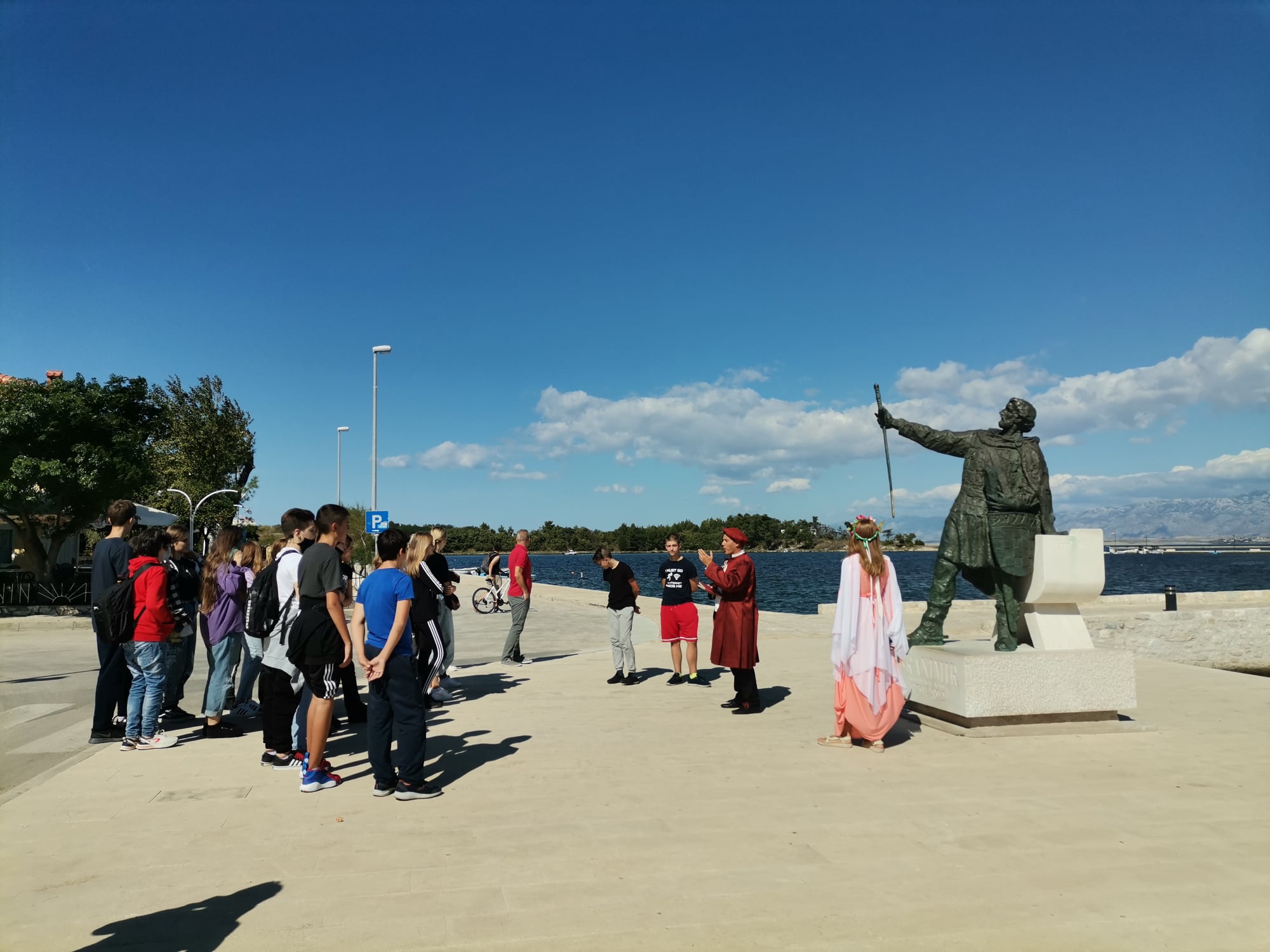
Photo: Official Facebook Page of the City of Nin Tourist Board
The Living History event was organized by the Tourist Board of the city of Nin. The goal was additional education through romantic stories of professional tourist guides. A group of 16 people had the opportunity to learn about how Prince Branimir received letters from Pope John VIII on June 7, 879 in the town of Nin, which at that time was interpreted as the first international recognition of the Croatian state. They toured the church of St. Anselm - the first cathedral in Croatia, the sacral heritage within the Parish Treasury of St. Anselma: reliquaries with the powers of Nin's heavenly patrons, a globally famous one Judas coin, the ring of Pope Pius II, and other valuables. Inside the church, they visited the miraculous statue of Our Lady of Zečevo and got acquainted with the church tradition of Nin saints, which according to tradition is associated with apostolic times. A monument to Gregory of Nin with an interpretation of the turbulent historical period and the struggle to preserve the Glagolitic alphabet was a must-see.
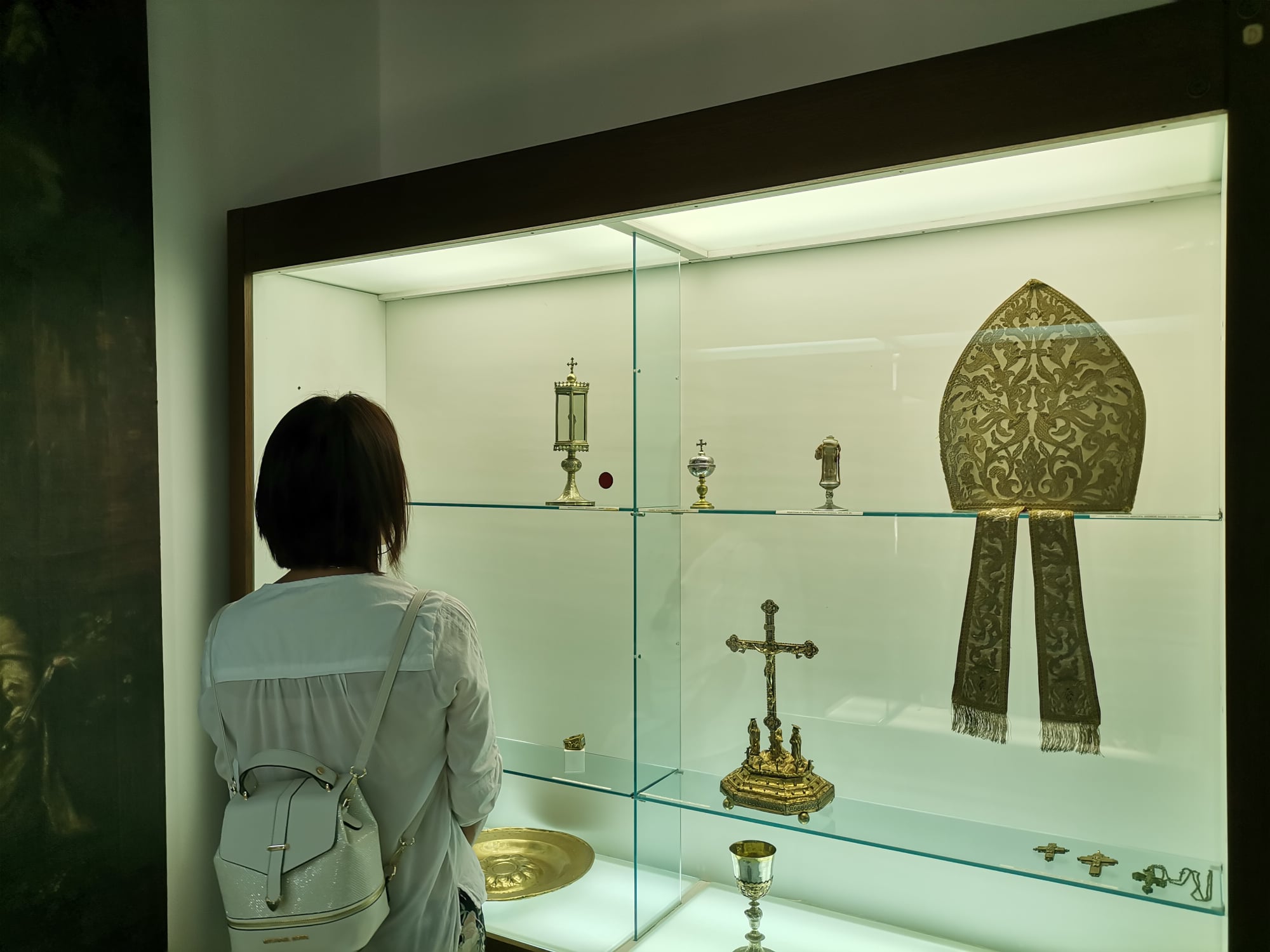
Photo: Official Facebook Page of the City of Nin Tourist Board
Next on the Living History program, members of the group toured the Museum of Nin Antiquities, which, along with materials from prehistoric, Roman, early Christian, and modern periods, preserves the originals of Condure Croatica, which are considered the most valuable exhibits because they have the level of national cultural treasure. After that, the site with the remains of Roman buildings from the first to the sixth century in the center of which proudly stands the church of St. Križa, popularly called the smallest cathedral in the world. A site with the remains of the largest Roman temple on the eastern side of the Adriatic from the first century was visited. After that, the site of the Roman domus with remarkably preserved mosaics was visited, and the group ended up touring the historic island in the memorial park dedicated to the famous Zoranić. There was an opportunity so the guides performed a new performance through which the group learned how the Bura wind got its name and other curiosities.
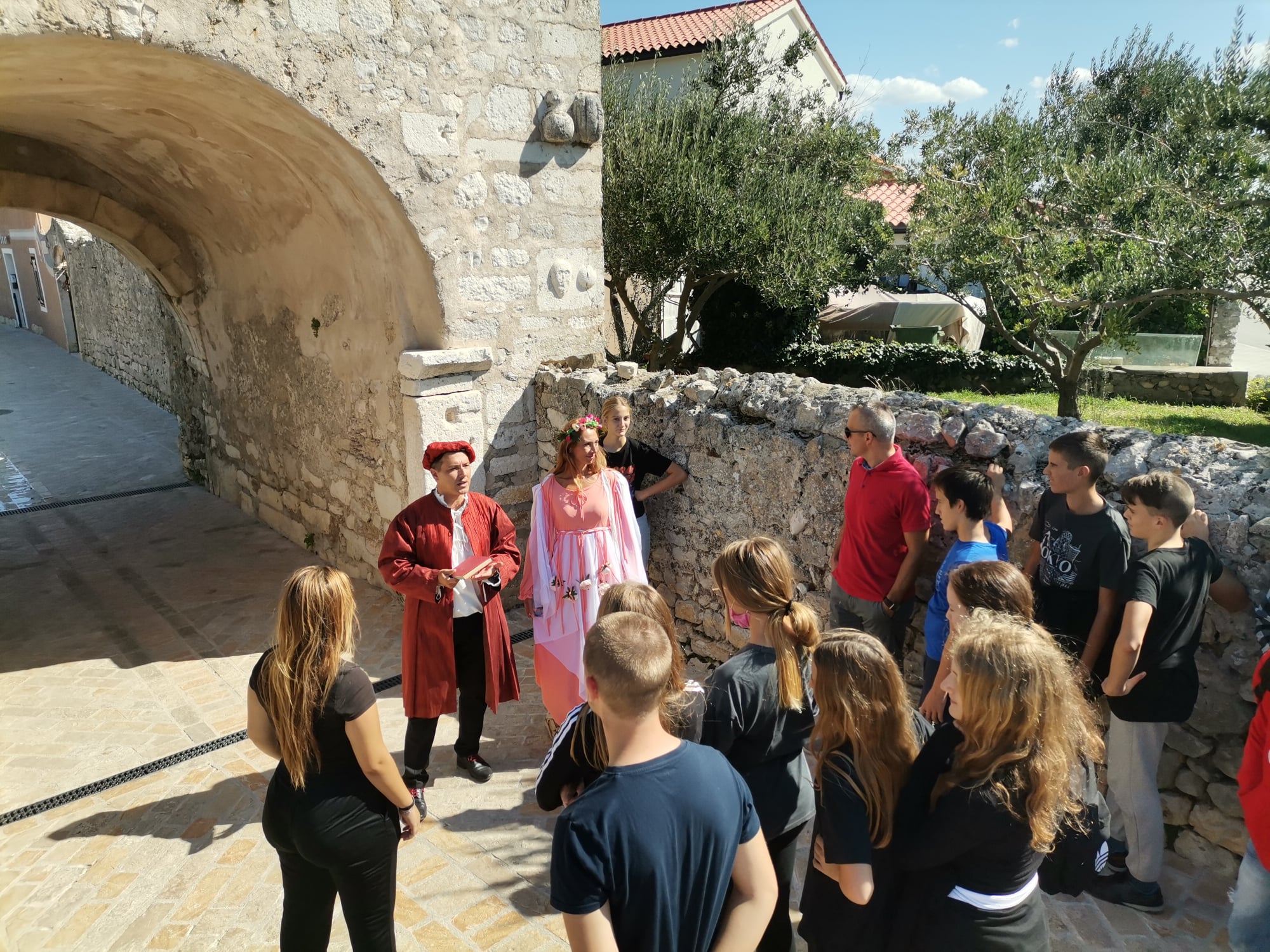
Photo: Official Facebook Page of the City of Nin Tourist Board
This concept has proven to be a very successful formula as it provides the opportunity for more fun and casual adoption of historical material. It was especially important to bring new data closer as tourism changes, and modern tourists are looking for new experiences, so this interpretation of heritage as a new tourist offer in Nin will be welcome. It is planned that visitors who will come to Nin through travel agencies will be able to participate in the so-called Living History program used as a method of interpreting historical heritage.
On the second day, a similar educational program was conducted in front of twenty-six eighth-grade students of Nin Elementary School, and the field lesson conducted by costumed guides was adapted to that age. First, the students learned through a performance that the Assyrian king Nino ordered a city to be built in Dalmatia and named after him, and that is the interpretation of the origin of the name of the city of Nino described in the Mountains by Zoranić. Among other interesting things, they went through an itinerary similar to the one that a group of adults had the previous day, but they showed great interest in the heritage of their city.
This educational program was performed for the first time, and it has already been agreed with the school management that it will be held every fall so that eighth grade students actively participate in the celebration of World Tourism Day while getting to know the history of their city more thoroughly.
To learn more about the region of Zadar and its sights, be sure to check Total Croatia's Zadar in a Page here
For more on travel in Croatia, follow TCN's dedicated page..
Longest Croatian Sandy Beach Listed Among Top 100 Most Beautiful Beaches
July the 26th, 2021 - The Croatian coast is stunning. With the coastline dotted with many islands, both inhabited and uninhabited, it isn't difficult to find a beautiful place to go swimming and soak up the sun's rays. That said, long sandy beaches aren't common along the country's rugged, mountainous coastline, but they do exist. The longest Croatian sandy beach is one which many have hailed to be among the most gorgeous of all.
As Morski writes, the long and natural sandy beaches of Nin spanning a total length of 8000 metres are one of this regions trademarks and an impressive image that is easily remembered by visitors to the oldest Croatian royal city. According to the American Travel Channel, the Queen's Beach (Croatian: Kraljicina plaza) is ranked among the 100 most beautiful beaches in the entire world.
The Queen's Beach is unique in many ways when one looks as the bigger picture of Croatia and the typical beaches it boasts. It is the longest Croatian sandy beach, and its name is associated with a prominent legend.
During his stay in Nin, the first Croatian king, King Tomislav, watched unforgettable sunrises with a breathtaking view of the Velebit mountain with his queen and enjoyed some very rare moments of pure relaxation.
Near this Croatian sandy beach is the largest locality of medicinal mud in all of the Republic of Croatia. Queen Jelena used to cover her entire body with this mud, and back in 1960, Nin was registered as a health resort on the coast with the organised Nin Outdoor Spa, where therapy under medical supervision has been taking place for almost 60 years during the warmer summer months.
Numerous wooden walking paths have been constructed which lead to this stunning Croatian sandy beach part through a unique area of biodiversity with as many as four habitats of the NATURA 2000 network with endemic and rare plant species living there. According to biologists, such a shaping of nature with this botanical garden is something truly unique here in Croatia, and perhaps in all of Europe.
Due to the shallow and warm sea, it is especially attractive to families with babies and small children and the elderly, and outside the main season it is a favourite place for long romantic walks.
For more on Croatian beaches, why not check out our dedicated section on Croatia for kids and families and decide which is the best choice for your holiday? Click here for more info.
10% of Mayoral Candidates Running Unopposed in May 16 Local Elections
ZAGREB, 4 May, 2021 - About 10% of the total of 555 towns and municipalities in Croatia already know who their mayors will be over the next four years because they are sole candidates running in the 16 May local elections.
The Croatian Democratic Union (HDZ) can already claim victory in four towns and 44 municipalities, as shown by the data on mayoral nominations available on the Electoral Commission's website.
This was also noted by the HDZ leader, Prime Minister Andrej Plenković, on Monday. "At this point the HDZ has already won in 48 local government units, which speaks of the strength of the HDZ candidates and the strength of the party," he said.
The ruling party has thus already secured mayoral posts in four towns - Pakrac, Skradin, Nin and Hrvatska Kostajnica. The majority of municipalities where the HDZ candidates are running unopposed are located in eastern Osijek-Baranja County.
In addition to the HDZ, some other parties have also already notched victories.
The Istrian Democratic Party (IDS) has sole candidates in two municipalities, the Social Democratic Party (SDP) and the Croatian People's Party (HNS) each have one such candidate and candidates of the Independent Democratic Serb Party (SDSS) will face no opposition in three municipalities.
In the southern municipality of Muć, the present long-serving mayor, who is running as an independent, is also the sole candidate.
For more about politics in Croatia, follow TCN's dedicated page.
Open Door Day on Thursday and Every Two Weeks at Solana Nin
Nin, a small town in Zadar County of just over 1,000 inhabitants (over 2,000 in the municipality), is well known throughout Croatia for its long history and its traditional saltworks.
As Morski writes on the 11th of June, 2019, Nin's saltworks, Solana Nin, where all of the town's saltwork is still done traditionally and by hand, is set to open its doors to interested visitors on June the 13th, 2019. What this means is that it will be possible for locals and visitors alike to visit Solana Nin and its Salt Museum for free.
The salt in Nin has been being cultivated in the same way for 1,500 years, as has been evidenced previously by archaeological discoveries from the Illyrian and the Roman period, just to name two.
Just two years ago, a terrible flood all but destroyed Nin's precious saltworks, as the water flooded all of the buildings, as well as the salt pools themselves. Despite the enormous levels of damage to the area, the salt managed to recover, and today, visitors to this significant part of town are able to see the tools with which the salt has been collected throughout history, as well as an exhibition space, the interior of which is coated with salt.
Although this event has been announced as an ''open doors days, hinting at it being very much a one-time thing for visitors to be able visit Solana Nin free of charge, this practice will actually be repeated every two weeks going forward.
It is interesting to note that the production of salt here is still done by hand, as it always used to be, so, in addition to baring witness to the finished product, it is possible to experience the entire process itself, which will give anyone who is planning to come to Nin over the next few days an additional reason to visit.
Make sure to follow our dedicated lifestyle page for much more.
How are Croatian Towns, Cities and Counties Doing with EU Fund Withdrawal?
Just how do various Croatian towns, cities and counties compare in terms of EU fund withdrawal? Some unlikely names have appeared on top...
As Novac/Gradonacelnik.hr writes on the 14th of May, 2019, through the Rural development program, the Republic of Croatia will have over 2.3 billion euro (over 17 billion kuna) from EU funds provided to it to boost competitiveness of agriculture, forestry and processing industries from 2014 to 2020.
The aforementioned EU funds will also be used to improve general living and working conditions, ie, the construction of necessary infrastructure such as kindergartens, fire stations and social housing in rural areas.
As of the end of January this year, at least according to official data, of this more than 17 billion kuna, 10.37 billion kuna was contracted for projects, and a little more than half of that contracted amount was paid out.
Croatian cities, according to that same data (APPRRR), have withdrawn more than 438 million out of a total of 5.66 billion kuna in the past five years. As many as fifteen Croatian towns that are on top of the list in terms of the withdrawal of EU funds from the rural development program are smaller towns, when taking the per capita amount into consideration. That list of Croatian towns which withdrew the most money per capita was led by Nin with 4915 kuna per capita. In total, this ancient town close to the popular destination of Zadar has withdrawn 13.4 million kuna. The town of Nin readily awaited the Rural development programs from 2014 to 2020, Mayor Emil Ćurko stated.
''Investments in project documentation were prepared, public-legal conditions were prepared, investment took place in human resources, all for the purpose of the withdrawal of EU funds. The projects are large, infrastructural, necessary, and we've prepared them so that the maximum amount of European Union funds are used. From each measure, we tried to extract the most funds allowed by the tender condition. We've shaped a project team working on the preparation and implementation of EU projects and we believe that we'll continue to do even better,'' said Ćurko.
Among several other things, Nin received approval for the construction of a kindergarten worth 9.2 million kuna, out of which 6.6 million kuna is being provided by the EU, and 2.6 million kuna is from Nin.
Following Nin are Hrvatska Kostajnica (2745 kuna), Klanjec (2717 kuna), Opuzen (2377 kuna), and Mursko Središće (2276 kuna), followed by Skradin, Grubišno Polje, and Ozalj.
Orahovica has withdrawl 7.4 million kuna until now, and in December, the town was approved once again for almost nine million kuna for the reconstruction and extension of a kindergarten.
''There are still a lot of projects in the plan of the authorities when it comes to other EU funds. They have been prepared in the past year and a little over six months, and the more funds we withdraw from the EU and state funds, the more there is in the budget, which will raise the standard of Orahovica's citizens through various programs,'' said Mayor Ana-Marija Petin.
Mursko Središće, in turn, led the list of total funds received from the Regional development program by the end of January, with 14.3 million kuna of withdrawn funds. This small town in the northernmost part of Croatia received 6.8 million kuna for road construction to help develop the economic zone and 7.4 million kuna for the construction and equipping of kindergartens.
Following in terms of the total amount of funds is Koprivnica, with 13.9 million kuna of withdrawn funds, followed by Slatina with an amount of total withdrawn funds standing at 13.8 million kuna, with Nin coming fourth place with the same amount, and with Karlovac coming fifth on the list, having attracted less than 12 million kuna. Karlovac used those EU funds for the construction of kindergartens, totalling 4.4 million kuna.
On the list of Croatian cities and towns that have withdrawn the most funds, there is another medium-sized town - Bjelovar, which has withdrawn 11.5 million kuna.
In terms of Croatian counties, the Eastern Croatian county of Osijek-Baranja has contracted the most EU funds, or more precisely 1.3 billion kuna for numerous projects. Following are Sisak-Moslavina, Virovitica-Podravina and Pozega-Slavonia, all of which are continental counties.
Make sure to follow our dedicated lifestyle and business pages for much more.
Treasure Hunt - Heritage Pursuit Tours in Zadar, Split and Nin
Treasure hunt walking tours have recently become popular all over the world, and recently there have been some attempts to popularize them in Croatia as well. The most successful story of the treasure hunt walking tour in Croatia comes from a tourist guide from Zadar, Valentina Matešić, who organizes her tours in Zadar, Nin and Split, and who's recently received the award as the top tourist guide for the town of Zadar in 2018!
Valentina is a mother who has decided to create the tours in a way that would make them interesting for the adults and the children alike, making them a perfect way to get to know a town for the entire family. You will solve puzzles presented by the "game", and learn about Croatian history and UNESCO-protected heritage while having fun. And the towns where she organizes her tours are places where there's a lot of history and heritage to be discovered! You'll find out why Zadar and Split are so different, although we know they're both Roman towns, you'll learn all about the Roman walls around Zadar, you'll find out about the amazing history of a small place, like Nin, where the coronations of Croatian kings took place. In Split, you'll find out what it takes to live in the emperor's personal bathroom (spoiler alert: about 2000 years of passage of time!)
Valentina Matešić says that one of the most amazing things is that many locals find her tours interesting, including school kids who come to her treasure hunts to learn about history while walking around the towns and having fun. We're sure that knowledge sticks much better than what you'd get in a classroom!
You can take the Treasure hunt - heritage pursuit tours in English, French and of course Croatian, and you can find out more at the CityGame Croatia website.
Nin Leads Croatia in Terms of Budget Revenue and Surplus
Nin leads the way.
Unusual Exhibition Opening at Nin Antique Museum
Nin is set to showcase just how Roman women went about their days, and what efforts they put into looking good...


